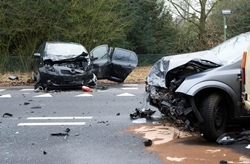Car accidents are a serious cause of injury and death. And it’s predicted that road traffic injuries will be the fifth leading cause of death around the globe by the year 2030. Knowing the types of accidents that occur most frequently, why they happen, and the injuries they can cause can help you and your family avoid them.
Common Car Accidents and Their Causes

Car crashes in Virginia happen every 4.37 minutes, and these wrecks can end in either mild or devastating injuries, leaving victims with lost wages, medical bills, the prospect of ongoing treatment, or disability. Distracted and drunk driving, speeding, weather conditions, and driver inattention often lead to these most common types of wrecks:
- Rear-end collisions. A rear-end accident occurs when the front end of one vehicle collides with the back end of another. Commonly, rear-end wrecks can be linked to sudden stops made by the leading vehicle, following too closely by the rear vehicle, distracted driving, or general lack of attention—and the fault almost always lies with the trailing vehicle. After suffering a rear-end accident, victims can suffer severe or mild whiplash, bruising, or internal organ injuries, depending on the rear vehicle’s speed at the time of the accident.
- T-bone or side-impact accident. During a side-impact collision, the front end of one vehicle crashes into the side of another vehicle at a perpendicular angle, which creates a T shape. Most frequently, these accidents occur at intersections, where cross traffic is common. Drivers who illegally run through red lights or fail to yield in left or right turns at intersections create the greatest risk for an accident. Only the doors and windows protect passengers in a T-bone crash; however, since that sector of a vehicle does not absorb as much of the energy created by a crash as the front or rear end, severe lacerations, internal bleeding, whiplash, and head injuries often result.
- Head-on collision. A head-on crash happens when the front ends of two vehicles collide, usually because one vehicle drifts out of its lane and into oncoming traffic. Because these crashes often happen at high speeds on highways and freeways, they are frequently fatal. Medical emergencies, drowsiness, intoxication, distraction, dangerous weather, and inattention are common causes. Besides death, head-on crashes can have serious consequences such as broken bones, traumatic brain injury (TBI), paralysis and spinal cord injuries, and internal bleeding.
- Rollover accident. Before landing on the side or roof, a car experiencing a rollover accident flips on its side and keeps rolling. A rollover most commonly involves one car, but another may have a part in the accident, too. Vehicles swerving to avoid road obstacles or other vehicles, poor weather conditions, or dangerous interactions between drivers commonly lead to rollovers. Because of their jarring and dramatic nature, these accidents often lead to serious injuries like internal bleeding, broken bones, head injuries, and even death.
- Hit and run. After an accident, both motorists (or any other parties involved such as pedestrians) are legally required to stay at the scene, wait for police and medical help, and exchange contact and insurance information. A hit-and-run occurs when one driver intentionally leaves the scene of the accident, often to avoid a run-in with law enforcement or insurance consequences. Those who leave accidents may have outstanding traffic tickets, be intoxicated, be wanted for other crimes, or feel scared of the legal consequences. Because car accidents can end in injury or death, leaving the scene is illegal—even if you’re not the at-fault driver.
Finding Legal Help
Any type of accident can lead to injuries, and it’s important you seek legal help to ensure you get fair compensation. The skilled attorneys at Kearney, Freeman, Fogarty & Joshi can assist you in building a case to recover for property damages and bodily injuries. Call us at 703-691-8333 to get answers about your case.
|
Related links: |

